Rosa indica fragrans hybrids - Rosaceae - hybrid tea rose, Teerose Hybriden
Hybrids of the tea rose Rosa indica fragrans = Rosa gigantea x R.chinensis developed in the 19th century as fragrant garden roses.
„Crossing Chinese roses with European varieties of roses in the 19th century, the first „modern“ roses - the hybrid tea roses - have been developed.“ https://de.wikipedia.org/wiki/Teerose_%28Rose%29
Main components of the headspace of hybrid tea roses were 1,3-dimethoxy-5-methylbenzene (1-74%), 2-phenylethanol (10-57%), citronellol (0-14%), and geraniol (0-45%). „…it is noteworthy that this compound [1,3-dimethoxy-5-methylbenzene] did not exist in the Rosa damascena and the Rosa centifolia as used in perfumery. This compound disperses a humid and fresh green note with a little phenolic and spicy character, and reminds us of a flower shop. This compound appeared to be the fragrance component that gave the scent of the tea rose and the hybrid tea rose a character distinct from that of the perfumery rose.“
[Nakamura, Shoji. „Scent and component analysis of the hybrid tea rose.“ Perfum Flavor 12 (1987): 43-45]
The comparative headspace analysis of flowers of a delicately scented yellow tea rose revealed interesting differences between living and picked flowers (living/picked): (Z)-3-hexenyl acetate (20.7/5.4%), hexyl acetate (8.4/4.3%), phenylethanol (5.7/3.3%), phenylethyl acetate (5.5/1.5%), 3,5-dimethoxytoluene (10.0/18.6%), α-elemene (0/4.1%), geranylacetone (2.2/0%), dihydro-β-ionol (0/2.6%), β-caryophyllene (0.3/2.1%), α-farnesene (5.8/3.0%).
[The chemistry of flowers, fruits and spices: live vs. dead-a new dimension in fragrance research., Mookherjee, B.D., Trenkle, R.W., Wilson, R.A., Pure and Applied Chemistry, Vol.62(7), 1990, 1357-1364] http://media.iupac.org/publications/pac/1990/pdf/6207x1357.pdf
The pink to bright-red coloured Floribunda grandiflora hybrid 'Queen Elizabeth' (Lammerts, USA, 1954, teahybrid 'Charlotte Armstrong' x 'Floradora') shows its ancestry with 3,5-dimethoxytoluene (DMT, 50.3%) in the headspace. The blossoms give off a very unusual fruity-raspberry-like scent with dihydro-β-ionone (17.3%), dihydro-β-ionol (3.4%), theaspiranes (16.8%), (Z)-3-hexenyl acetate (1.1%), and 4-vinylanisole (1.9%).
[Brunke, Ernst‐Joachim, Franz‐Josef Hammerschmidt, and Gerhard Schmaus. „Scent of roses–recent results.“ Flavour and fragrance journal 7.4 (1992): 195-198]
Main components of the headspace of flowers of the beautiful hybrid tea rose ‚Baronne E. De Rothschild’ (purple-Solferino petals with a silvery reflection on the underside), collected on Tenax, were esters (91.1%), with large amounts of (Z)-3-hexenyl acetate (45.1%) and hexyl acetate (32.9%).
,Sutters Gold‘ (with copper yellow petals veined by orange and carmine) is characterized by an oriental rose scent with fruity (cherry) and cognac undertones. The dominating esters (75.5%) included (Z)-3-hexenyl acetate (23.7%), hexyl acetate (26.8%), phenylethyl acetate (16.3%), and geranyl acetate (4.2%). Orcinyl dimethylether (3,5-dimethoxytoluene; DMT; 14.2%) was distinctly present, together with phenylethanol (3.2%), nerol (2.8%), citronellol (1.8%), and also the rose oxides (0.18%).
'Meispola' ('Yonina') is a variety of hybrid tea rose with distinctive elegant double pure white blossoms having a delicate fragrance. Main group of components were esters (55.8%), like (Z)-3-hexenyl acetate (26.5%), hexyl acetate (26.2%), and geranyl acetate (2.1%), alongside 3,5-dimethoxytoluene (DMT; 29.0%) and citronellol (5%).
The hybrid tea rose 'Fragrant Cloud' ('Duftwolke', 'Fragrant Cloud'), showed also esters esters (48.8%) as the most abundant components, like phenylethyl acetate (19.3%), hexyl acetate (12.3%), (Z)-3-hexenyl acetate (9.7%), and citronellyl acetate (7.1%). Olfactorly interesting compounds were also phenylethanol (14.8%), citronellol (5.8%), p-vinyl anisole (11.0%), β-ionone (0.7%), rose oxides (0.2%), and estragol (0.1%).
'Jardins de Bagatelle' ('Meimafris'; 'Karl Heinz Hanisch'; creamy white petals with pink undertones) owns a typical rosy-lemon-like scent with β-caryophyllene (16.2%), hexyl acetate (15.5%), (Z)-3-hexenyl acetate (14.0%), DMT (9.6%), and rose oxide (0.5%). „This rose is the champion of β-ionone-containing roses with a level of 5.7%.“
There are varieties of hybrid tea roses which contain more than 40% of DMT ('aromatic ether type'):
'Sylvia' (W.Kordes) had DMT (67.3%) together with anisole (0.1%), p-vinylanisole (1.1%), β-ionone (2.7%), rose oxides (0.5%), nonanal (0.9%), and decanal (0.9%).
'Youki San' ('Meidonq') showed DMT (55.8%), anisole (1.4%), p-vinylanisole (0.6%), together with hexyl acetate (3.3%), (Z)-3-hexenyl acetate (1.6%), and a tpiycal scent derived from phenylacetaldehyde (1%).
'Papa Meilland' is a dark velvet red tea hybrid rose with a lemon peel note added to the typical classical rose scent. Aromatic ethers present are DMT (40.3%), accompanied by benzyl methyl ether (2.7%), and p-vinylanisole (1.6%). Other major components were citronellol (29.4%), phenylethanol (1.8%), hexyl acetate (12.6%), citronellyl acetate (3.1%), rose oxides (1.5%), and β-caryophyllene (1.0%).
[Flament, I., C. Debonneville, and A. Furrer. „Volatile constituents of roses: characterization of cultivars based on the headspace analysis of living flower emissions.“ chapter in: Volatile compounds from Flowers, Teranishi, R.;Buttery, R. G.;Sugisawa, H. Bioactive volatile compounds from plants. (Book) 1993, 269-281]
In the case of the hybrid tea rose 'Fragrant Cloud' ('Nuage Perfume', 'Tanellis') it has been shown that emitted amounts of volatiles of uncut or cut flowers may be the same, with identical rhythm of individual components. This rose emitted (Z)-3-hexenyl acetate (max. 12% of total volatiles), n-hexyl acetate (max. 2.2%) and (Z)-2-hexenyl acetate (max. 4.6%) with peak output between 8-12 a.m., and on the other side, citronellol (10%) after noon till night. Geraniol had peaks at 8 a.m. in the morning and at noon (8%).
[Trapping, Investigation and Reconstitution of Flower Scents, Roman Kaiser, in: Müller, P.M., and Lamparsky, D. eds. Perfumes: Art, Science and Technology. Springer Science & Business Media, Dordrecht 1994, 213-250]
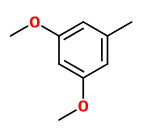 3,5-dimethoxytoluene (DMT) (tea-like) | 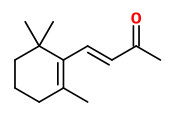 β-ionone (woody sweet) | 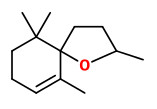 theaspirane A/B (fruity cassis) |  2-phenylethyl acetate (sweet rose honey) |
Many modern garden roses are hybrids of Rosa gigantea and Rosa chinensis, both rich in carotenoid-derived scent components like β-ionone, dihydro-β-ionone, corresponding alcohols and spiro-compounds like the theaspiranes. A typical example is the famous yellow old garden rose 'Marechal Niel', which scent is dominated by carotenoid metabolites (ionones, theaspiranes) and by 3,5-dimethoxytoluene (DMT).
„3,5-Dimethoxytoluene and its frequent companion 1,3,5-trimethoxybenzene are clear markers indicating Rosa gigantea and R.chinensis in the scents of modern roses.“
Headspace of hybrid tea rose cultivars analysed by R.Kaiser:
Marechal Niel (DMT 11,5%, β-ionone 3.9%, dihydro-β-ionone 3.9%, theaspirane A/B 0.6%)
Parure d'Ore (DMT 17,6%, p-vinyl anisole 8.1%, β-ionone 3.9%, theaspirane A/B 0.4%)
Paul Richard (DMT 33.0%, β-ionone 0.3%, theaspirane A/B 0.4%)
Rose Dot (DMT 6.5%, Z-3-hexenyl acetate 27.5%, 2-phenylethyl acetate 36.0%, theaspirane A/B 0.3%)
Sutter's Gold (DMT 4.0%, geranyl acetate 18.0%, 2-phenylethyl acetate 14.0%, geraniol 19.1%)
Fragrant Cloud (DMT, theaspirane A/B, cyclic β-ionone, dihydro-β-ionone, β-ionone, dihydro-β-ionol)
[Meaningful Scents around the World, Roman Kaiser, Zürich 2006, 159-164 and 256-259]
„Orcinol O-methyltransferase (OOMT) 1 and 2 catalyze the last two steps of the biosynthetic pathway leading to the phenolic methyl ether 3,5-dimethoxytoluene (DMT), the major scent compound of many rose (Rosa x hybrida) varieties.
Nowadays, phenolic methyl ethers are emitted by flowers from most modern rose varieties (Flament et al., 1993). However, the progenitors of modern roses included both European species (e.g. Rosa gallica, Rosa phoenicia, and Rosa moschata) and Chinese species (e.g. R. chinensis and Rosa gigantea), and, interestingly, emission of phenolic methyl ethers was originally restricted to Chinese rose species and was not found in the European species .
Using a polyclonal antibody raised against recombinant OOMT1, we show here that OOMTs accumulate specifically in petals. No OOMT protein was detected in stamens, despite the presence of transcripts in this organ, indicating that OOMT expression is repressed in stamens by a posttranscriptional mechanism. In petals, the accumulation of OOMT proteins followed the previously described pattern of transcript accumulation, and enzyme levels reached a maximum in the freshly open flower (stage 4), when scent biosynthesis is most active.
Most modern rose varieties produce DMT as a component of their scent, having inherited this trait from their Chinese progenitors (Nakamura, 1987; Flament et al., 1993; Joichi et al., 2005). However, while DMT production is almost universal in modern rose varieties, this is not true for older European varieties, which do not produce phenolic methyl ethers (Flament et al., 1993). Investigating the reasons for this absence in two European roses, R. gallica and Damask rose, we found that neither OOMT activity nor OOMT protein could be detected in the floral organs of these varieties. The genomes of both R. gallica and Damask rose contain OOMT homologous sequences, but these genes are not expressed at detectable levels in either floral organs or leaves.“
[Role of petal-specific orcinol O-methyltransferases in the evolution of rose scent., Scalliet, G., Lionnet, C., Le Bechec, M., Dutron, L., Magnard, J.L., Baudino, S., Hugueney, P., Plant physiology, Vol.140(1), 2006, 18-29]
http://www.plantphysiol.org/content/140/1/18.full
Different substrate specificities of orcinol O-methyltransferases OOMT1 and OOMT2 are mostly due to a single amino acid polymorphism in the phenolic substrate binding site of OOMTs. „… the emergence of the OOMT1 gene may have been a critical step in the evolution of scent production in Chinese roses.“
[Scent evolution in Chinese roses., Scalliet, G., Piola, F., Douady, C.J., Réty, S., Raymond, O., Baudino, S., Hugueney, P., Proceedings of the National Academy of Sciences, 105(15), 2008, 5927-5932]
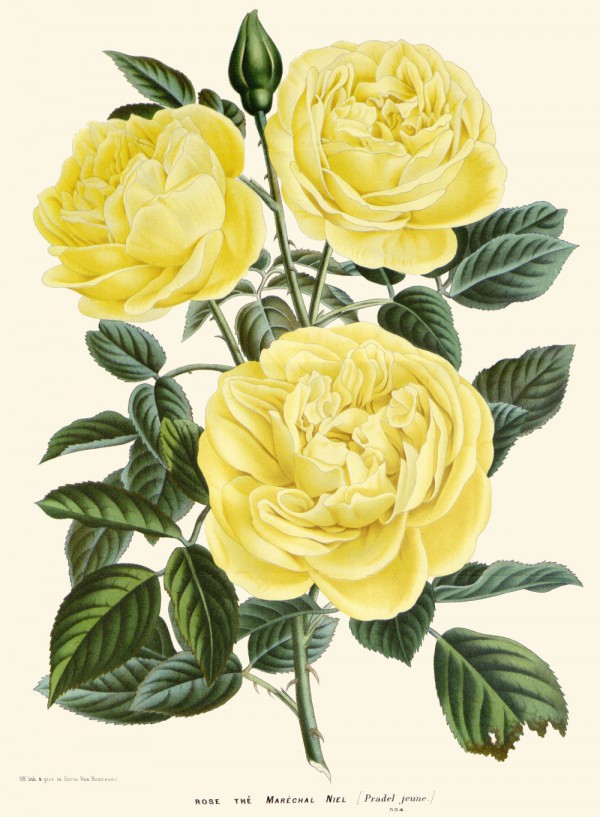
Rosa hort. cv. Thé Maréchal Niel; Houtte, L. van, Flore des serres et des jardin de l’Europe, vol.16 t.1640 (1845)
http://plantgenera.org/taxa.php?id_taxon=7167
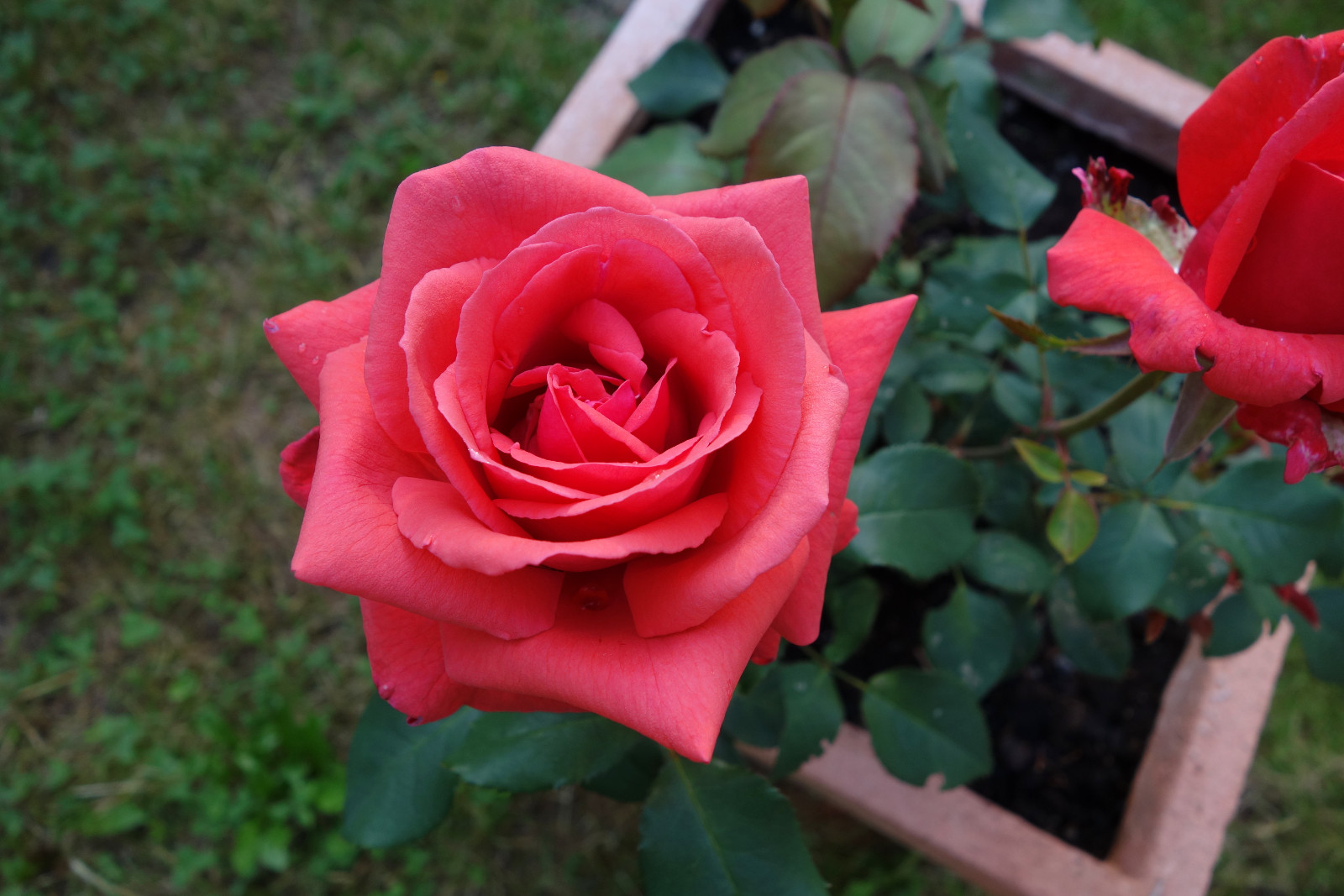
hybrid tea rose 'Duftwolke' (Fragrant Cloud), CC BY-SA 3.0, Author: Andreas Kraska
